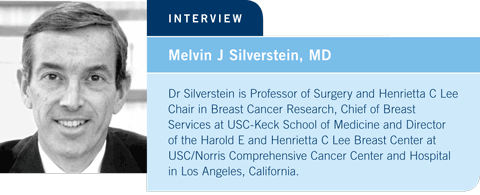
 |
||||||||||||||

| Tracks 1-16 | ||||||||||||||||||||||||||||||||||
|
Select Excerpts from the Interview
Track 7
![]() DR LOVE: Has anything new emerged in the debate about ductal carcinoma
in situ (DCIS) and radiation therapy?
DR LOVE: Has anything new emerged in the debate about ductal carcinoma
in situ (DCIS) and radiation therapy?
![]() DR SILVERSTEIN: The debate asks, does every patient with DCIS need
radiation therapy? I’m on the “no” side. The proponents — the NSABP and
some radiation therapists from the East Coast — believe that everybody needs
radiation therapy.
DR SILVERSTEIN: The debate asks, does every patient with DCIS need
radiation therapy? I’m on the “no” side. The proponents — the NSABP and
some radiation therapists from the East Coast — believe that everybody needs
radiation therapy.
Clearly American physicians and patients don’t buy into that because the Surveillance, Epidemiology and End Results (SEER) data suggest that about 35 percent of patients with DCIS in this country do not undergo radiation therapy (Baxter 2004).
![]() DR LOVE: What fraction of your patients with DCIS don’t receive radiation
therapy?
DR LOVE: What fraction of your patients with DCIS don’t receive radiation
therapy?
![]() DR SILVERSTEIN: Probably double that. We try hard not to administer radiation
therapy, but some patients do receive it. At the American Society of
Breast Surgeons meeting we presented an update of our 1999 DCIS paper, in
which we found that patients with 10-mm margins had an extremely low local
recurrence rate — two or three percent — with or without radiation therapy
(Silverstein 1999).
DR SILVERSTEIN: Probably double that. We try hard not to administer radiation
therapy, but some patients do receive it. At the American Society of
Breast Surgeons meeting we presented an update of our 1999 DCIS paper, in
which we found that patients with 10-mm margins had an extremely low local
recurrence rate — two or three percent — with or without radiation therapy
(Silverstein 1999).
Now they have all been followed for a median of 123 months. The recurrence rates are only slightly higher for the excision-only patients (in the range of seven percent) versus the radiation therapy patients (about two and a half percent).
Compare that to the gold standard set by the NSABP: At 12 years they have a 16 percent recurrence rate for all their patients with DCIS who undergo excision with radiation therapy (Fisher 2001).
![]() DR LOVE: Of course, that’s an indirect comparison.
DR LOVE: Of course, that’s an indirect comparison.
![]() DR SILVERSTEIN: Yes, it’s indirect and not a fair comparison. However, our
data show exactly what the randomized trial data show: If you administer radiation
therapy, you decrease the relative recurrence risk by about 50 or 60 percent.
DR SILVERSTEIN: Yes, it’s indirect and not a fair comparison. However, our
data show exactly what the randomized trial data show: If you administer radiation
therapy, you decrease the relative recurrence risk by about 50 or 60 percent.
Among the patients with 10-mm margins, that translates to an absolute benefit of only about five percent. I have to irradiate 100 patients to prevent five recurrences, of which only two will be invasive.
I can also cure at least eight out of 10 invasive recurrences because we follow them closely. This means I have to irradiate 400 patients to prevent one death.
Track 8
![]() DR LOVE: Can you discuss the prognosis of invasive local recurrence after
DCIS?
DR LOVE: Can you discuss the prognosis of invasive local recurrence after
DCIS?
![]() DR SILVERSTEIN: We’ve evaluated the long-term prognosis of invasive recurrences.
At 12 years, approximately 15 percent of those with invasive recurrence
had metastatic disease and about 12 percent died (Lee 2006; [1.1]).
DR SILVERSTEIN: We’ve evaluated the long-term prognosis of invasive recurrences.
At 12 years, approximately 15 percent of those with invasive recurrence
had metastatic disease and about 12 percent died (Lee 2006; [1.1]).
Among our recurrences in excision-only patients, 34 percent were invasive. Among patients who received excision and radiation therapy, 53 percent of recurrences were invasive. That’s approximately a 20 percent difference, which is statistically significant.
Why is that happening? I believe it’s because some patients treated with radiation therapy develop fibrosis. When that happens, their mammographic follow-up is much more difficult. People believe it’s just scarring, but when the biopsy is done, it’s actually a large, invasive tumor.
We can prevent recurrences with radiation therapy, but if a patient develops a recurrence, it has a higher probability of being invasive. That evens the issue out for us.
What it boils down to is how much risk a patient wants to take. In medical oncology surveys, some women have said, “For a one percent survival benefit, I’ll be happy to receive the chemotherapy.”
We can reduce the recurrence rate for patients with 10-mm margins from seven or eight percent to two or three percent. Only two of those recurrences are invasive. If you treat 250 patients with 10-mm margins, you will probably save one life.
But what are the costs of radiation therapy? Not every radiation therapist is a great radiation therapist. Will everybody use CT planning and protect the heart and lungs? Will you see more lung cancer, more esophageal cancer, more pulmonary disease or more heart disease?
Radiation techniques are much better today than they were in 1980, so I believe you have a good chance of preventing much of that, but you can’t prevent it all.

| Table of Contents | Top of Page |
Editor:
Neil Love, MD
Interviews
Melvin J Silverstein, MD
- Select publications
David M Hyams, MD
- Select publications
Charles E Geyer Jr, MD
- Select publications
Hope S Rugo, MD
- Select publications
Highlights of a CME Symposium Held in Conjunction
with The American Society of Breast Surgeons Eighth
Annual Meeting
- Select publications
A CME Audio Series and Activity